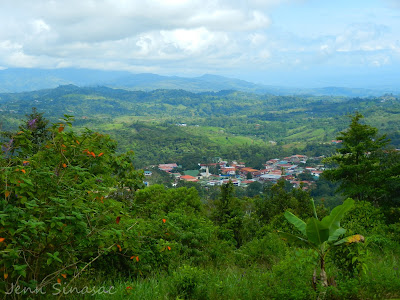I feel fortunate to have had some great field experience in Latin America. From tracking Harpy Eagles and Orange-breasted Falcons in Central America, to conducting various surveys for birds, reptiles, amphibians, butterflies and more in Ecuador, I have gained a wide range of experience dealing with a variety of taxa, and I feel it leaves doors open for more opportunities.
In February, I was on the Panama Rainforest Discovery Center tower, and I met Alison Olivieri, the president of the San Vito Bird Club in southern Costa Rica. We chatted for a while on the tower, and she asked me if I had any experience in mist-netting and bird banding, because they were in need of volunteers for their control monitoring session in July. We swapped contact information and were in touch immediately. She contacted me in May with the set dates for the session, and I accepted. It worked out perfectly, since it was to the date of when I needed to exit Panama for my visa purposes as well. So on July 11, I boarded the night bus to David, en route to Costa Rica.
 |
| Yellow-headed Caracaras (Milvago chimachima) in San Vito |
Four buses and a border crossing later, I arrived in San Vito, a small town set in a picturesque valley in the foothills of the Talamanca Mountain Range in southern Costa Rica, not far from the Panama border. The fresh air was a welcomed break from the heat and humidity of Gamboa, and I got settled in for my week in Costa Rica. I was met by Monique and Marcel Girard, a Canadian couple from Quebec who moved to San Vito 19 years ago. Since I arrived a day before the project was to start, they offered me one of their beautiful cabins for my first night there for a very reasonable rate. They were so lovely - they made me feel like family, offered me lunch (and breakfast the following day), took me on a driving tour of scenic San Vito and the surrounding area, and showed me their beautiful property, where I immediately started birding! An Orange-billed Nightingale-Thrush, Rufous-breasted Wrens, Cherrie's, Silver-throated Tanagers, and Gray-capped Flycatchers foraged in the trees and shrubs, while Swallow-tailed Kites and Yellow-headed Caracaras soared overhead.
The next day, I met Alison to help set up the mist nets at the first site. With a good crew, we set up 15 nets in an hour, and we were ready for the next day. Alison dropped me off at Wilson Botanical Garden and Las Cruces Biological Station in time for lunch, where I stayed during the session days. The combination of a botanical garden and biological station makes for the most beautiful biological station I have ever seen. Manicured gardens full of native and international flora, and beautiful trails through primary and secondary forest, attracts a great diversity of wildlife. That evening, our banding expert - Pablo "Chespi" Elizondo and intern Isabel Martin arrived for the session as well. We got acquainted and prepared for the next several days of bird banding.
The San Vito Avian Monitoring Project is a 10-year long-term monitoring project that focuses on resident and migrant species. They run 4 sessions a year, at 3 locations near San Vito. This session is the control session, in July/August, when there are no migrants present. What we did expect was young birds hatched this year, and some breeding birds, which take advantage of a high food supply to raise their young when no migrants are there to compete. The project is in its 9th year.
 |
| View of San Vito from Finca Cantaros |
Our first morning at Finca Sofia was fantastic, our best of the 6 mornings and 3 locations - we netted 72 individuals of 25 species, and 35 individuals of those were hummingbirds, mainly Green Hermits and Rufous-tailed Hummingbirds (stay tuned for more highlights). The other mornings followed with a constant stream of birds as well, and the last morning was the quietest, where we were actually able to stop in between net rounds and eat some breakfast. We banded 2 mornings at each of the 3 locations (Finca Sofia, Finca Cantaros and Finca Cortesa), and lucked out with the weather, thankfully for the "San Juan Veranillo" we managed to avoid rain every morning. At Finca Cantaros, a public-use garden, we welcomed a 5th-grade class of "Detectivos de Pajaros" for an up-close experience with the mist-netting project, which challenged our small team in terms of continuing with the bird banding in the morning, as we ran the hour-long program for the kids. It was a big hurdle for me, as it was the first time I had conducted an education program in Spanish! I can now check that one off the list and I look forward to more!
Please read more for bird and other wildlife highlights, and photos!
~ Jenn
No comments:
Post a Comment